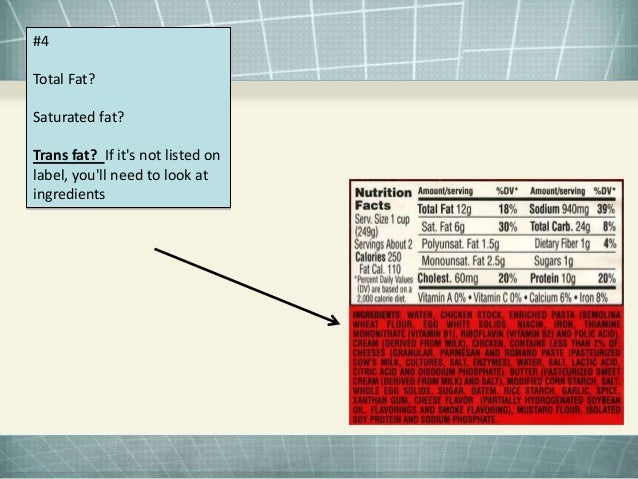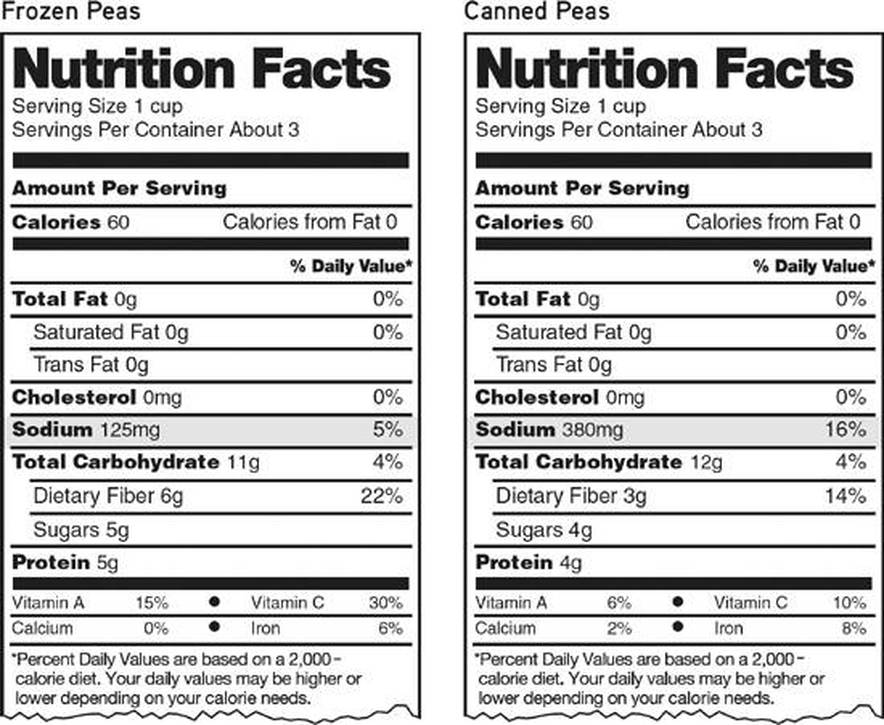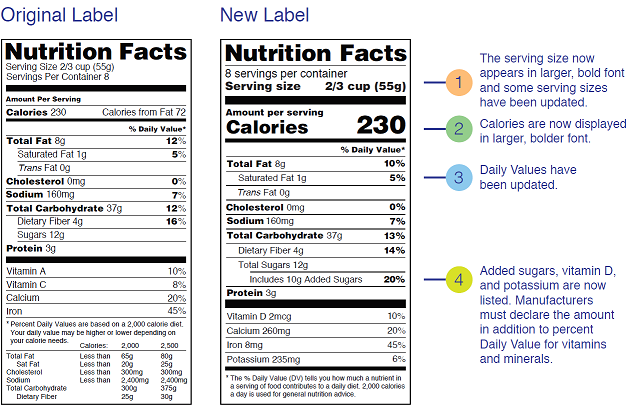43 reading calories on food labels
How to Read Nutrition Facts Label - Food Network The American Heart Association recommends no more than 100 calories from added sugar per day (about 6 teaspoons or 24 grams of sugar) for most women and no more than 150 calories per day (about 9 ... Food labels - NHS Colour-coded nutritional information tells you at a glance if the food has high, medium or low amounts of fat, saturated fat, sugars and salt: red means high amber means medium green means low In short, the more green on the label, the healthier the choice.
3 Ways to Read Nutrition Facts on Food Labels - wikiHow Foods that tend to have a low caloric content are usually good for you, like avocado, celery, or corn. Empty calories refer to calories that are low in nutritional value, like pizza, soda, or sausage. 2 Read the fat content in a serving and check what types of fat are present.

Reading calories on food labels
How to Read Food Labels + Nutrition Facts • Healthy.Happy.Smart. You must juxtapose the food quantity of food you do eat with the serving size on the label. Consuming huge portions can result in weight gain. The bigger your food portions are, the higher the calories you consume. For instance, the label may indicate a serving size as 8 Irish potato chips. How to Read Food Labels Without Being Tricked - Healthline Low-calorie products have to have one-third fewer calories than the brand's original product. Yet, one brand's low-calorie version may have similar calories as another brand's original. Low-fat.... How to Understand and Use the Nutrition Facts Label | FDA That is two times the calories and nutrients shown in the sample label, so you would need to double the nutrient and calorie amounts, as well as the %DVs, to see what you are getting in two...
Reading calories on food labels. How to Read Nutrition Labels - Verywell Fit The column on the right side of the nutrition label has numbers displayed in percentages. The numbers listed under "% Daily Value" tell you how much a particular nutrient contributes to your total daily diet if you consume 2,000 calories per day. If you consume more or less than 2,000 calories per day, these figures will not be accurate for you. How to Read Nutrition Labels in 2019 - Healthline knowing that your calorie needs may differ from the 2,000 calories-per-day baseline on labels. realizing that the nutrient values on labels are listed per serving size — and keeping track of how ... How to Read Nutrition Facts Labels the Right Way - GoodRx Nutrition Facts labels are required to list the total fat, saturated fat, and trans fats on packaged food products. It's important to choose foods with the right kinds of fats. Here are the differences between the fats you'll see on the label. Bad fats Saturated and trans fats are the less healthy types of fats. How to Read Carbohydrates on Food Labels - GlycoLeap That would be around 15 to 30 g of carbohydrates. Snack = 15 - 30 g of carbohydrate. For the main meals (breakfast, lunch, dinner), 2 to 3 servings of carbs would be enough. That is about 30-45 g of carbohydrates. 3 servings of carbohydrates are about the size of 1 fist size of rice.
Reading Nutrition Labels - Cronometer This label type can be found on most American branded products. Key features include: Energy measured in Calories only, Convenient serving size measurement (e.g. cups, oz, fl. oz, Tbsp) Vitamin D, Iron, Calcium, Potassium %DV (based on 2000 kcal diet) Some of the Daily Values have changed. How to read food labels - Heart Foundation NZ The star rating is calculated using an algorithm that takes into consideration a number of positive and negative nutrients for a particular food. The positive elements include protein, fibre, fruit, vegetable, nut, seed and legume content. The negative elements include energy, sodium, saturated fat, and sugar. How Do They Calculate Calories on Food Labels? It's important to recognize that 4-9-4 is an average, and not an exact amount. For example, 1 gram of fat in one food may yield 8.34 calories while 1 gram of fat from another food yields 9.7 calories. The same thing happens with carbohydrate and protein: the 4-9-4 is an average, not an exact amount. How To Read Nutrition Labels All the nutrition info — including calories — refer to the amount in one serving. 2. Check the calories in one serving 40 calories is low, 100 calories is moderate, 400 calories or more is high. Remember: If you eat multiple servings, you'll need to multiply the calories by the number of serving that you eat. 3. Check the % Daily Value
Understanding Food Nutrition Labels | American Heart Association 1 - Start with the serving information at the top. This will tell you the size of a single serving and the total number of servings per container (package). 2 - Next, check total calories per serving and container. Pay attention to the calories per serving and how many calories you're really consuming if you eat the whole package. The Basics of the Nutrition Facts Label A food item with a 5% DV of fat provides 5% of the total fat that a person who needs 2,000 calories a day should eat. You may need more or less than 2,000 calories per day. This means that you may need more or less than 100% DV that is listed on the package for some nutrients. Low is 5% or less. PDF How to Read the Food Label - Risk Services This is the number of calories you'll eat in one serving of a food. Calories needed each day depends on your age, sex, height, weight, and amount of physical activity. Estimates range from 1,600 to 2,400 calories for women and 2,000 to 3,000 calories for men. If you're trying to lose weight, avoid or limit high-calorie foods. How To Read Food and Beverage Labels | National Institute on Aging Or you can call the U.S. Department of Agriculture's Food and Nutrition Information Center at 301-504-5414. Understanding percent Daily Value (% DV) The percent Daily Value (% DV) tells how much a nutrient in a serving of the food or beverage contributes to a total daily 2,000-calorie diet.
Quick Tips for Reading the Nutrition Facts Label shows how much a nutrient in a serving of the food contributes to a total daily diet. As a general guide: 5% DV ... Quick Tips for Reading the Nutrition Facts Label The Nutrition Facts Label Tip ...
How to Read a Nutrition Facts Label - The Family Meal Project 100 calories per serving is considered moderate 400 calories per serving is considered high 3. Look at the nutrition terms: The nutrition terms on the label are there to tell you more about some of the nutrients in the food item you are looking at Calorie Free - less than 5 calories per serving Low Calorie - 40 calories or less per serving
This Is How to Read a Nutrition Facts Label on the Keto Diet This act mandated that, with a few exceptions, all packaged foods needed nutrition labels — thus creating the black-and-white labels we see on packaged foods today. The nutrients that required labeling included: Calories Calories from fat Total fat Saturated fat Cholesterol Sodium Total Carbohydrate Dietary fiber Sugars Protein Vitamin A Vitamin C
How to Read Nutrition Labels - HealthHub Focus on the key nutrients that are important to you. If you are on a diet, look at the energy or calorie values. For people with high blood pressure, zoom in on the sodium value or check the saturated fat and cholesterol amounts if you have high cholesterol. Be mindful of fat content; no more than 30 per cent of your daily calories should come ...
Food Labels | CDC Check the Serving size first. All the numbers on this label are for a 2/3-cup serving. This package has 8 servings. If you eat the whole thing, you are eating 8 times the amount of calories, carbs, fat, etc., shown on the label. Total Carbohydrate shows you types of carbs in the food, including sugar and fiber.
How-To Guide for Reading Food Labels - SecondsCount The General Guide to Calories provides a general reference for calories when you look at a Nutrition Facts label. This guide is based on a 2,000 calorie diet. 3. Limit These Nutrients. When following heart-healthy guidelines, it is helpful to use the Nutrition Facts Panel to find information about fat, cholesterol and sodium in foods. These are ...
Understanding Food Labels | The Nutrition Source | Harvard T.H. Chan ... One might assume the small bag to contain 1 serving, but it actually contains 3 servings so that eating the whole bag provides 300 calories. With the updated label, the same size bag would show 1 serving at 300 calories. Keep in mind that the serving size is not a recommendation for everyone about how much to eat, but rather a reference point.
Food label reading guide | Nutrition Australia What to look for when reading food and drink labels (per 100g) Health Star Ratings The Health Star Rating is a front of pack labelling scheme which can be used to make healthier food choices at a glance. The rating range is from ½ - 5 stars and the more stars, the healthier the choice. Recommended minimum star ratings for food and drink categories
Reading and Understanding Food Labels and Nutrition Info - Beaumont Health Many fresh meats, poultry and fish do not have a nutrition facts label. The average cholesterol per ounce of an animal product is 25 mg. Percent of calories from fat Divide the calories from fat by the total calories. Keep in mind not every food you eat needs to contain less than 30 percent of the calories from fat.
How to Read Nutrition Facts | Food Labels Made Easy - YouTube To support our channel and level up your health, check out:Our Fast Weight Loss Course: B...
How to Understand and Use the Nutrition Facts Label | FDA That is two times the calories and nutrients shown in the sample label, so you would need to double the nutrient and calorie amounts, as well as the %DVs, to see what you are getting in two...
How to Read Food Labels Without Being Tricked - Healthline Low-calorie products have to have one-third fewer calories than the brand's original product. Yet, one brand's low-calorie version may have similar calories as another brand's original. Low-fat....

Reading food labels should be as much of a habit as exercise. | Reading food labels, Macmillan ...
How to Read Food Labels + Nutrition Facts • Healthy.Happy.Smart. You must juxtapose the food quantity of food you do eat with the serving size on the label. Consuming huge portions can result in weight gain. The bigger your food portions are, the higher the calories you consume. For instance, the label may indicate a serving size as 8 Irish potato chips.










Post a Comment for "43 reading calories on food labels"